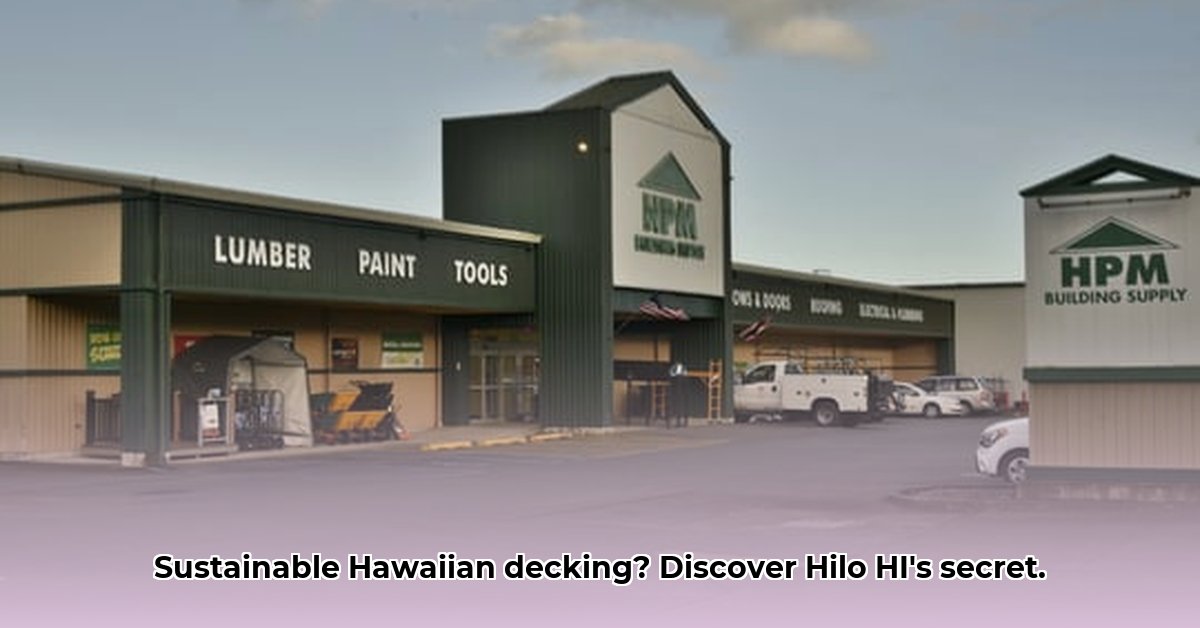
Choosing the right decking for your Hilo home is more than just aesthetics; it's a decision with significant environmental implications. Hawaii's unique climate—intense sun, humidity, and termites—demands durable, long-lasting decking. This article compares two popular options: composite and sustainably-sourced wood decking, analyzing their environmental impact and helping you make an informed, sustainable choice for your Hawaiian home. For more local options, check out HPM Hilo.
Choosing Sustainable Decking for Your Hawaiian Home
The ideal Hilo deck should blend seamlessly with the island landscape while minimizing environmental impact. Wood and composite decking offer distinct advantages and disadvantages, each impacting sustainability differently. Let's delve into the details to illuminate the best choice for your home.
Wood Decking: Island Charm with Environmental Considerations
The natural beauty of wood decking, especially locally-sourced Hawaiian hardwoods, evokes the island spirit. It's a tangible connection to the land, offering a warm, inviting aesthetic. However, this idyllic image has a counterpoint. Wood decking requires diligent maintenance to resist termites, rot, and the elements. Regular staining, sealing, and pest control are essential, adding to the long-term costs and your environmental footprint. Furthermore, ensuring the wood comes from sustainably managed forests is crucial. Imported lumber significantly increases the carbon footprint through transportation. Thus, while visually appealing, wood's sustainability hinges on responsible sourcing and consistent upkeep.
Composite Decking: Low Maintenance, High Environmental Considerations?
Composite decking, a blend of recycled plastic and wood fibers, promises low-maintenance convenience. Its resistance to rot, insects, and fading attracts busy homeowners. But the initial convenience belies a complex environmental picture. The manufacturing process is energy-intensive, often using fossil fuels and generating substantial greenhouse gas emissions. The long-term sustainability of composite decking also requires careful examination. Recycling methods are still developing, raising concerns about end-of-life management. Therefore, although low-maintenance, its overall environmental cost requires consideration, particularly the lifecycle impact on Hawaii’s environment.
Wood vs. Composite: A Comparative Analysis
The choice between wood and composite decking boils down to prioritizing certain factors. The table below offers a direct comparison to aid in your decision:
| Feature | Wood Decking | Composite Decking |
|---|---|---|
| Upfront Cost | Generally lower | Generally higher |
| Ongoing Maintenance | High (staining, sealing, pest control) | Low (minimal upkeep) |
| Lifespan | Moderate (climate-dependent); shorter in humid environments | Long (decades with proper care) |
| Environmental Impact | Highly variable; lowest with local, sustainably-sourced wood; high with imported lumber | High embodied carbon; end-of-life recycling remains a developing area |
| Availability | Locally sourced, sustainably harvested wood may be limited; imports common | Widely available |
Making Your Sustainable Choice: A Step-by-Step Guide
Deciding on the right decking material demands careful consideration of various factors. Here’s a structured approach:
- Prioritize Your Needs: Determine your key priorities: budget, time commitment, environmental impact, and aesthetic preferences.
- Budget Assessment: Consider the upfront costs and ongoing maintenance expenses. Composite decking often requires a larger initial investment.
- Time Commitment Evaluation: Wood decking demands significant ongoing maintenance. Assess your willingness and ability to dedicate the necessary time.
- Environmental Impact Analysis: Evaluate the complete lifecycle impacts of each option. Research the sourcing of materials and their end-of-life management.
- Explore Local Options: Prioritize locally sourced wood from sustainable sources to minimize transportation-related emissions. HPM Hilo HI is an excellent resource for local options.
Expanding Your Perspective: Sustainability Beyond Materials
Sustainability extends beyond the material itself. The installation process and end-of-life disposal significantly influence the overall environmental footprint.
- Eco-conscious Installation: Choose installers committed to sustainable practices, minimizing waste and employing environmentally friendly techniques.
- Responsible Disposal: Plan for the eventual disposal or recycling of your deck. Research materials with easier recycling options or repurposing potential. This forward-thinking approach minimizes long-term environmental impact.
Your Sustainable Decision: Aligning Values with Choices
Ultimately, the choice between wood and composite decking depends on your personal values and priorities. By carefully weighing the factors discussed, you can make an informed decision that aligns with both your lifestyle and your commitment to environmental stewardship. Consult with experts at your local HPM Hilo HI store for personalized guidance. They can offer valuable insights based on your specific needs and help you find the best sustainable decking solution for your beautiful Hawaiian home. Remember, a sustainable deck is an investment in your home and the future of Hawaii.